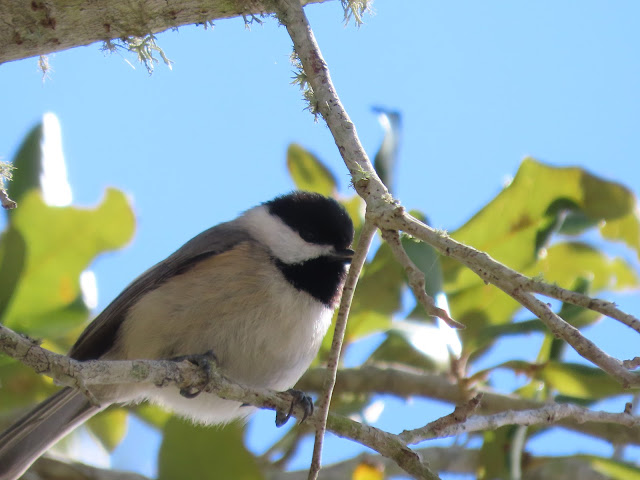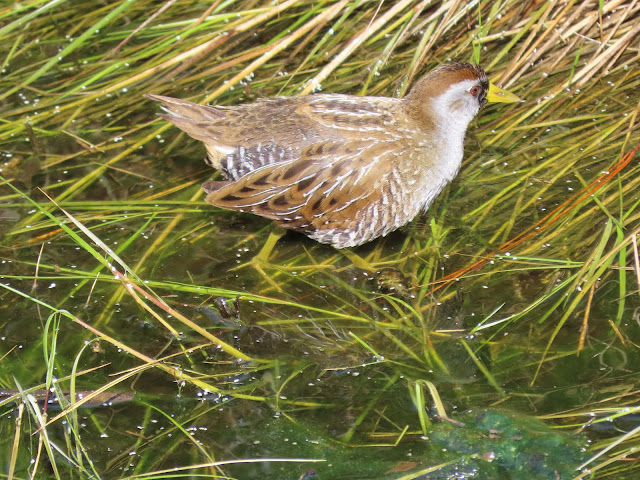Sunday January 24th
Recently made my annual trip to North Florida and the Panhandle. Spent four days checking out birding Hot Spots including The Celery Fields, Fort De Soto Park, Sweetwater Wetlands, Gainesville-Hawthorne Trail, St Marks NWR, Lake Jackson Mounds State Par, Crowder Landing, Torreya State Park and Paynes Prairie State Park. Usually like to include Florida Caverns State Park, but most of the property remains off limits from damage from Hurricane Michael over two years ago
Day 1 - Saturday |
| Purple Martins taking up residence at the martin house at The Celery Fields |
First stop was a short visit at The Celery Fields in Sarasota County. Some of the birds observed included the recently arrived
Purple Martins, plus
Blue-winged Teal, Long-billed Dowitchers, Least Sandpipers, Nanday Parakeets, Least Sandpipers, Northern Harriers, Bald eagles, Lesser Yellowlegs, Roseate Spoonbills and Brown-headed Cowbirds. Dipped on any rails, bitterns, purple gallinules etc.
 |
| Red-breasted Merganser seen at the fishing pier at Fort De Soto Park |
From Sarasota traveled to Tampa Bay. At the rest stop stop at he north end of the Skyline bridge was able to add a couple of hundred Black Skimmers, plus my FOY sighting of a Common Loon. Several Red-breasted Mergansers and Great Egrets were present.
 |
| Forster's Tern at Fort De Soto Park |
Next was a stop at Fort De Soto Park, which sits in Tampa Bay. Was here to observe sea ducks, shore birds and such. Just before reaching the park, checked the Terra Verdi Ponds which were loaded with hundreds of Lesser Scaup and Redhead ducks. Began birding at the North Beach at Fort De Soto. Some of the birds here included Wilson's Plover, Black-bellied Plover, Sanderlings, Semipalmated Plovers, Short-billed Dowitchers, Dunlins, Ruddy Turnstones, Ring-billed Gulls and various wading birds.
 |
| Whimbrel seen at the Fishing Pier |
Left this spot to check the two fishing piers for any scoters, loons or horned grebes. ended up with four Common Loons, but no scoters or grebes. Did have well over a hundred Laughing Gulls, plus Ring-billed Gulls, Herring Gull, Royal, Sandwich and Forster's Terns. Had nice looks at a pair of Whimbrels. Also had more Red-breasted Mergansers, American White & Brown Pelicans, Cormorants, Osprey and Palm Warblers.
 |
| Black-bellied Plover at the Fishing Pier |
Wrapped up the in Gainesville. First checked out any activity along the Gainesville-Hawthorn Trail. This now paved, but former railroad line was wayyy to popular on this Saturday afternoon, for any serious birding. The traffic on the path was terrible, with skate boarders, cyclists, runners and people using transport I hadn't seen before. In the past I had seen chipping sparrows, cedar waxwings, ruby-crowned kinglets, Carolina chickadees and more. But not today.
 |
Armadillo rooting for dinner
at Sweetwater Wetland |
Last stop was the Sweetwater Wetlands. Arrived here close to closing and that was fine. Cause the Rusty Blackbirds come into roost just at sunset. Before getting to the rusty blackbird stack-out spot, spent time looking for any other interesting birds. Some of these included Black-bellied Whistling Ducks, Buffleheads, Sora, and a Merlin bomb a flock of roosting cowbirds.
The Park Ranger set me up on the spot to wait for the rustys to arrive and as I was waiting I noticed a group of birds scanning and scoping the marsh nearby and suspected that they were also waiting on the rustys to arrive. Turns out they were friends of mine from home. Dave and Tammy McQuade had met up with Eary and Jennifer Warren and their two kids in Gainesville to look for the Rusty Blackbirds and a Calliope Hummingbird. The Warrens had driven up from Cape Coral and the McQuades' were wrapping up a very successful cross-country birding trip.
 |
| Bufflehead at Sweetwater Wetlands |
Got to see the
Rusty Blackbirds, about 60 of them. So I was now done for the day, with another long day tomorrow.
 |
| Pied-billed Grebe at Sweetwater Wetlands |
 |
| Silhouette of a Rusty Blackbird. Best I could get in the fading light |



















































